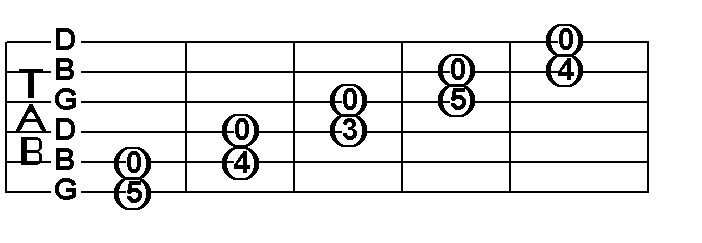Mike Moxcey ©2005
Dobro Tuning
The dobro was invented in Hawaii by the Dopero Brothers who inserted a banjo resonator into a guitar body, raised the strings to play a slide on, and tuned them open.
The dobro is tuned to open G and looks a lot like tuning the classic 5-string banjo in G-tuning
G B D G B D from the 4th string to the first.
-
The basic tuning strategy is to
- tune the 6th string, the heaviest one, to a G note from a piano or tuner or pitchpipe or some other device.
-
Then you fret the 6th string at the 4th fret and tune the 5th string to that note (B).
-
Then you fret the 5th string at the 3rd fret and tune the 4th string to that note (D).
- Now you have two options, keep going up to fret or use harmonics.
Let's first follow on with what we were doing.
-
Fret the 4th string at the 5th fret and tune the 3rd string to that note (G).
-
Then you fret the 3rd string at the 4th fret and tune the 2nd string to that note (B).
-
Then you fret the 2nd string at the 3rd fret and tune the 1st string to that note (D).
Here is what the tuning notes look like in tab. For each pair of doubled notes, the open string is the one you’re trying to tune and the fretted one is the note you strike first to hear what the open string should sound like.

Harmonics Tuning
- After tuning the bottom three strings (4,5,6), you can also use harmonics to tune the top three because they are each an octave above the lower strings respectively
- Pluck the octave harmonic (12th fret) on the 6th string and tune the the 3rd string to it (G)
[To play the harmonic, touch the string directly above the 12th fret and pluck it to get a bell-like sound]
- Then pluck the octave harmonic (12th fret) on the 5th string and tune the the 2nd string to it (B)
- Then pluck the octave harmonic (12th fret) on the 4th string and tune the the 1st string to it (D)

The horizontal lines on the tab are strings.
The bottom line of the tab stands for the top string, the 4th string or the heaviest one on the banjo.
The top line of the tab stands for the 1st string of the banjo, the one that is closest to the floor.
The numbers mean to pluck a string.
“0” means pluck it open (unfretted).
A number means to fret the string at the appropriate number and then pluck it.
Techniques Index

